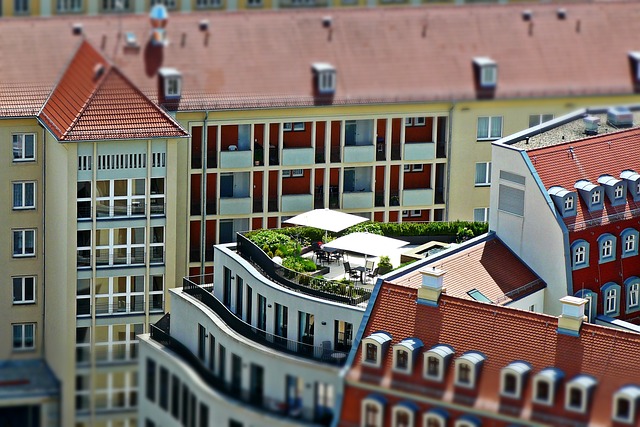Cool roof solutions, driven by the need to combat urban heat islands and promote sustainability, leverage advanced materials like reflective pigments and coatings to reduce solar absorption. These innovations lower surface temperatures, offering significant energy savings for both residential and commercial buildings. The market caters to diverse needs with options including white cool roofing and eco-friendly green roofs. As a growing trend in sustainable cities worldwide, cool roof technology continues to evolve, providing durable, aesthetically pleasing alternatives while contributing to reduced carbon footprints. Key benefits include lower cooling bills, enhanced insulation, and mitigating the urban heat island effect, making these solutions an effective approach for both residential and commercial properties.
Cool Roof Solutions: A Comprehensive Overview
Cool roof solutions have emerged as a powerful strategy to combat urban heat islands, offering both environmental and economic benefits. These innovative designs utilize advanced materials and technologies to reflect sunlight, thereby reducing the absorption of heat by buildings and surrounding infrastructure. Cool roof installation involves applying reflective roofing systems or cool roof coatings onto surfaces, which can significantly lower surface temperatures compared to traditional dark roofs.
The growing demand for energy-efficient cool roofs has led to the development of various solutions suitable for both residential and commercial applications. White cool roofing, for instance, uses highly reflective pigments to bounce sunlight away from the building, reducing heat gain. Eco-friendly cool roofs integrate natural elements like green roofs or light-colored vegetative covers, enhancing insulation while promoting biodiversity. Cool roof technology continues to evolve, promising more durable and aesthetically pleasing alternatives to conventional roofing systems.
– Definition and significance of cool roofs in mitigating urban heat islands.
Urban heat islands (UHIs) are areas within urban environments that experience significantly higher temperatures than surrounding rural regions. This phenomenon is primarily attributed to the absorption and retention of heat by buildings, roads, and other infrastructure. Cool roofs offer a promising solution to mitigate UHIs through reflective roofing systems, which significantly reduce the amount of solar energy absorbed. By reflecting sunlight back into the atmosphere, these energy-efficient cool roof solutions help lower surface temperatures, thereby decreasing the overall urban heat island effect.
Cool roof installations have gained traction in both residential and commercial sectors due to their environmental and economic benefits. White cool roofing, for instance, has been shown to decrease rooftop temperatures by up to 30°C during peak summer months. Moreover, eco-friendly cool roof coatings not only reflect light but also improve insulation, leading to reduced energy consumption for cooling purposes. As cities worldwide strive to become more sustainable, the adoption of such innovative cool roof technologies is becoming increasingly vital in addressing the urban heat island challenge.
– Types of cool roof systems and their working principles.
Energy-Efficient Cool Roofs: Design and Installation Tips
Cool roofs have emerged as a powerful tool in the fight against urban heat islands, offering an innovative solution to mitigate the effect of rising city temperatures. These roofs are designed to reflect a significant portion of sunlight, thereby reducing the amount of heat absorbed and re-radiated into the atmosphere. Energy-efficient cool roof solutions are particularly beneficial for both residential and commercial buildings, as they can lower cooling costs and contribute to a more sustainable urban environment.
When considering cool roof installation, property owners should opt for reflective roofing systems or coat their existing roofs with specialized cool roof coatings. For residential properties, white cool roofing is an attractive option, providing not only heat reduction but also enhancing the visual appeal of homes. Commercial cool roofing, on the other hand, can be tailored to larger structures and industrial facilities, utilizing advanced cool roof technology to create energy-efficient spaces while reducing the overall carbon footprint.
– The energy savings potential of cool roofs.
Cool roofs have emerged as a powerful solution to combat urban heat island effects, offering significant energy savings potential for both residential and commercial buildings. By incorporating reflective roofing systems or cool roof coatings, surfaces can reflect a larger portion of sunlight, reducing heat absorption and interior temperature rise. This simple yet innovative approach can significantly lower cooling costs, especially in urban areas where traditional roofing materials contribute to elevated temperatures.
The installation of energy-efficient cool roofs presents a win-win scenario—not only do they provide environmental benefits by decreasing the urban heat island effect but also offer long-term financial savings for property owners. White cool roofing, for instance, has proven effective in reflecting solar radiation, making it particularly popular in regions with hot climates. As cool roof technology advances, residential and commercial properties can embrace eco-friendly solutions that enhance comfort while minimizing their carbon footprint.
In conclusion, adopting innovative cool roof solutions presents a promising strategy to combat urban heat island effects. By utilizing advanced technologies like reflective roofing systems, cool roof coatings, and energy-efficient designs, both residential and commercial properties can significantly reduce their carbon footprint and create more sustainable urban environments. The benefits extend beyond temperature regulation, offering cost savings and contributing to a greener, healthier future for urban communities worldwide.
